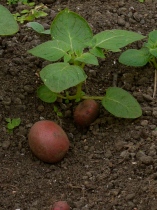The most important thing you can do, in my opinion, to grow a healthy, disease and pest-free garden is to build your soil. Therefore, the most important thing you can do to keep your garden pesticide and chemical fertilizer free is build your soil. And unfortunately, rototillers destroy soil rather than build it.
Soil is amazing and reflects the complexity of its Creator. It is so much more than weathered rock. Healthy soil also contains the decaying remains of dead plants and soil organisms, air, water and living organisms. It is these living organisms in particular that bring health to your soil and are destroyed by roto-tilling. It is said that a teaspoon of soil can contain billions of organisms! These organisms include fungi, bacteria, earthworms and anthropods. Listen to some of what these organisms do for your soil: they fix nitrogen from the atmosphere so that your plants can now use it, they aerate the soil, they break down toxins, suppress soil-borne diseases, and decompose organic matter. Some fungus even form symbiotic relationships with plant roots where each benefit from the other.
Ironically, we till to break up compacted soil, and in the end we compact it by tilling. Rototillers finely grind the soil killing the living organisms that are vital to soil health. Because the particles are so fine, aeration is diminished and soil structure is destroyed. The nutrient content of the soil is now compromised making fertilization necessary. Plants will be less healthy making them more prone to disease and pests. You can see how this downward spiral would make growing a garden organically more difficult.
If you are clearing a large area for a new garden and find it necessary to use a rototiller, try to make this the one and only time. Hand digging is preferred; although it may disrupt the soil organisms, it does not destroy them. I prefer no dig methods of gardening such as lasagna gardening. This is a wonderful way to build a garden that builds soil, and eliminates the back breaking task of digging a garden.
A good resource is Healthy Soils for Sustainable Gardens, a Brooklyn Botanical Garden Guide edited by Niall Dunne. Also recommended is Lasagna Gardening by Patricia Lanza.
Shared at Sunday School, Homestead Barn Hop, Tuesday Garden Party, Teach Me Tuesday, Frugal Days Sustainable Ways, Rural Thursday, Simple Lives Thursday, Farmgirl Friday, Garden Club Thursday, Garden Life































